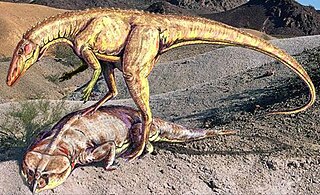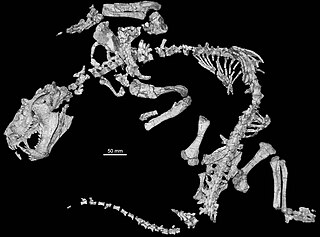
The Federal University of Santa Maria is a Brazilian public university located in Santa Maria, in the state of Rio Grande do Sul, funded by the federal government of Brazil. It was founded in 1960, by Professor José Mariano da Rocha Filho. Its campuses span over 1,837.72 ha, with a total of 386,968 m² of buildings and 28,307 students.

Traversodon is an extinct genus of cynodonts. It was a relative of the ancestor to modern mammals.

Stahleckeria is an extinct genus of Middle Triassic (Ladinian) dicynodonts. It lived about 240 million years ago in what is now Brazil and Namibia. As a member of the group Kannemeyeriiformes, it was similar to the genus Kannemeyeria. The genus is known from the type species Stahleckeria potens, which was first collected from the Ladinian-age Santa Maria Formation in the Paleorrota fossil site of Brazil. Stahleckeria was named in honor of Rudolf Stahlecker, who discovered the first specimens during a 1935 expedition led by paleontologist Friedrich von Huene to the Chiniquá fossil site.

The Sanga da Alemoa paleontological site is located in the city of Santa Maria, Rio Grande do Sul, in Brazil. It belongs to the Caturrita Formation and the Santa Maria Formation. It is located in the neighborhood of Castelinho. The site belongs to the paleorrota region.
The Paleontological Site of Agua Negra is located in the Agua Negra in the city of São Martinho da Serra, Rio Grande do Sul, Brazil. The site is approximately 8 kilometers from the city of Santa Maria. The site belongs to the region paleorrota. Here the Unaysaurus was found.

The Palaeontological Site Chiniquá is located in the Brazilian municipality of São Pedro do Sul, Rio Grande do Sul, along highway BR-287, about 70 kilometers west of the city of Santa Maria. The site occupies an area of about 250 hectares and is part of the geopark of paleorrota. It yielded fossils of Middle Triassic (Ladinian) age.

The Museum Vicente Pallotti is located on Avenida Presidente Vargas, 115 in Santa Maria, Rio Grande do Sul, Brazil. It is located in the same complex Palotina College (FAPAS). Visits need to be scheduled in advance.

Daniel Cargnin (1930–2002) was a Brazilian priest and amateur paleontologist born in Nova Palma, in the state of Rio Grande do Sul, Brazil, in 1930. He died in 2002, and at his request was buried in the town of Mata.
Protuberum is an extinct genus of traversodontid cynodonts known from a single species Protuberum cabralense, from the Middle Triassic of Brazil.
Rauisuchus is a genus of extinct archosaurs which lived in what is now the Geopark of Paleorrota, Brazil, during the Late Triassic period. It contains one species, R. tiradentes.
Procerosuchus is an extinct genus of loricatan archosaur. Fossils have been collected from the Late Triassic Santa Maria Formation in Geopark of Paleorrota, Rio Grande do Sul, Brazil, which is Carnian in age. The genus was first described by the German paleontologist Friedrich von Huene in 1942.

Trucidocynodon is an extinct genus of ecteniniid cynodonts from the Upper Triassic (Carnian) of Brazil. It contains a single species, Trucidocynodon riograndensis. Fossils of Trucidocynodon were discovered in outcrops of the Upper Santa Maria Formation in Paleorrota Geopark, Agudo. Trucidocynodon is one of the most completely known Triassic cynodonts, as its holotype is a nearly complete and fully articulated skeleton.

Cerritosaurus is a genus of proterochampsid archosauromorph from the Late Triassic. It has been found in the Santa Maria Formation, in the Geopark of Paleorrota, Brazil. It is represented by one species.
Guilherme Rau (?–1953) immigrated to Santa Maria, Rio Grande do Sul, Brazil from Germany in 1900. An ophthalmologist, from 1915 to 1917 he helped with the Geological Survey of Berlin's excavation of 200 fossil at the Paleontological Site Sanga of Alemoa. He also contributed considerably to the Geopark of Paleorrota and taught Botany at the Faculty of Pharmacy of the city in the years 1934 and 1935.
João Guilherme Fischer, also known as Jango Fischer was a Brazilian diplomat and scientist.
Vicentino Prestes de Almeida was a Brazilian paleontologist.
Romeu Beltrão (1913–1977), was a Brazilian physician, educator, historian and paleontologist. He was born and died in Santa Maria, Rio Grande do Sul, Brazil.
Mario Costa Barberena was a Brazilian paleontologist.
Jaci Antonio Louzada Tupi Caldas was a Brazilian paleontologist. He gave contributions to paleontology describing some of the animals found in the region Paleorrota.

The Paleontological Sites of Santa Maria are located in the city of Santa Maria, Rio Grande do Sul, Brazil and dating from the Triassic. Are in the Santa Maria Formation and Caturrita Formation.












